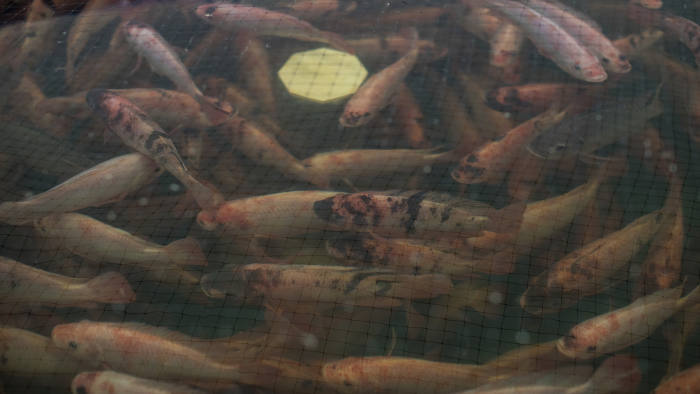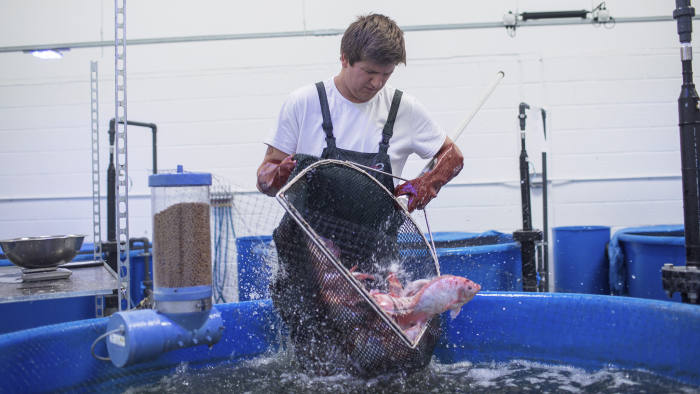Data Analysis, Tech And Fish Waste Make Urban Farms Viable
Data Analysis, Tech And Fish Waste Make Urban Farms Viable
Brexit boosts business in ex-bomb shelter that controls plants’ every growth variable
Nothing lost: Kate Hofman, chief executive of GrowUp, surrounded by produce nurtured by fish waste
09-25-17 | by Jennifer Thompson
The rows of plants under pinkish lights, tended inside a Dutch warehouse by white-coated workers, bring to mind more a sci-fi film set than a farm. Indeed, the start-up behind the scheme, PlantLab, prefers to describe itself as a “development company” rather than an agricultural business.
Urban farming itself is not new — people have always grown produce or raised livestock in towns and cities, from necessity, as a hobby or to reduce food miles. Now, however, city agriculturalists are harnessing technologies such as light-emitting diode (LED) bulbs, 3D printers and data analysis to speed up growth and create farms virtually anywhere.
In London, in a former bomb shelter underneath Clapham Common, for example, Growing Underground cultivates leafy greens, such as watercress, rocket and coriander.
Built to shelter up to 8,000 people during the second world war, its tunnels now house rows of plants. “It was all [done using] standard agricultural equipment, save for LEDs,” says Steve Dring, co-founder of Growing Underground. LEDs provide the right level of light and heat in an energy efficient manner.
Affordability has proved a big factor for spurring innovation. PlantLab grew out of an older traditional horticultural company, growing greens and soft fruits under glass and greenhouses but was officially launched in 2010 as LED lighting became more affordable. Growing Underground also works on a fast turnround, with a series of ‘mini harvests’.
Tanks of tilapia fish at GrowUp's aquaponics project provide nutrients for plants © Charlie Bibby/FT
Seeds spend three days in a dark, warm and humid environment to fool them into thinking they are surrounded by soil. They then grow for six to 12 days under the light before being harvested for the capital’s restaurants and more recently the London food stores of Marks and Spencer.
A few miles from Clapham, Kate Hofman and her team at GrowUp are also revamping existing equipment and concepts for an ambitious aquaponics project.
Having taken a sabbatical from her career as a management consultant to undertake a masters degree in environmental technology and business, Ms Hofman and co-founder Tom Webster wanted to create an economically viable and environmentally friendly food production system.
Tilapia fish at GrowUp's aquaponics project are reared with a smart monitoring system © Charlie Bibby/FT
The concept of aquaponics, which combines raising fish with growing plants for a mutually beneficial exchange of nutrients, has been around for thousands of years. Technology, however, is bringing a new precision to the process.
GrowUp, established in 2013, operates from a warehouse in east London housing 12 tanks each holding 3,000 litres of water and up to 400 tilapia fish. The waste of the fish nurtures plants growing above — including kale, watercress, and basil — while the plants filter the water, and a smart monitoring system gives complete control over elements such as humidity and temperature.
The impetus from the start was to create something that could succeed as a business.
“We’ve focused on how do you take that technology and make it commercial,” says Ms Hofman. “We were both interested in how hydroponics could be used to grow food commercially. The reality is most of our food production across the world happens on an industrial scale.” GrowUp is currently looking for a location for a second farm, expected to have around ten times the capacity of the original site. This would allow them to begin supplying supermarkets. Ms Hofman says the prospect of Brexit following the UK’s vote last year to leave the EU, has increased interest in the concept of localising food production and technology-driven farming projects have made some inroads into supply chains.
“It was quite obvious there were mathematical patterns in plant growth.” ARD REIJTENBAGH, CHIEF PARTNERSHIP OFFICER AT PLANTLAB
Advances in data analysis are also making these kinds of farms more productive. “It was quite obvious there were mathematical patterns in plant growth,” says Ard Reijtenbagh, chief partnership officer at PlantLab.
Increasing interest in data collection prompted PlantLab’s founders to consider the optimum circumstances in which to grow plants.
They designed and supply so-called ‘plant production units’, as well as software and growing recipes, where growing conditions are tightly controlled: more than 80 potential variables, across the light spectrum, and including humidity and even the movement of air can be altered. The control is so thorough that they can determine the level of iron or zinc in plants.
The combination of technology and farming can also have other benefits.
Nerve Centre, an arts centre in Northern Ireland, runs a ‘digital farm’ project to teach students with learning difficulties entrepreneurship and digital skills.
Students construct aquaponics systems using laser cutters and 3D printers and supply the produce to restaurants. They have just taken delivery of 100 juvenile carp, which may fetch between £60 and £70 each once they are fully grown in two years. John Peto, the centre’s director of education, says: “Some [students] have no interest in growing food but they’re really interested in using computers.” He also expects the cultivation of fish to have a therapeutic effect.



